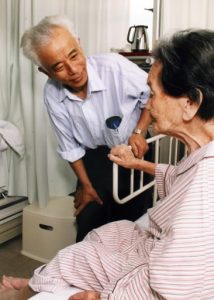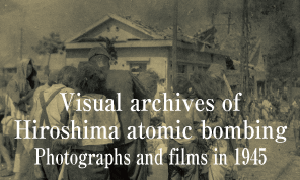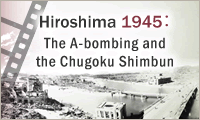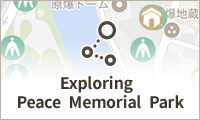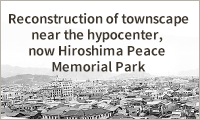Sarugaku-cho, neighborhood around A-bomb Dome, Part 1: Child of “parent and child” at hypocenter remains close to foster mother, aged 100
Jul. 25, 1997
by Masami Nishimoto, Staff Writer
The man who showed up at the meeting place was perfectly comfortable speaking Osaka dialect. “I came here after graduating from school and have lived here longer than I did in Hiroshima,” he said. From a paper bag he had brought with him to the family restaurant next to a domed stadium, he removed a photograph album and a full copy of his family register. The same information was recorded in the name fields for each of his four family members.
“Died at 8:30 a.m. on August 6, 1945, at 84 Sarugaku-cho, Hiroshima City.” That was the information listed for the four people in the family register — Sadao, 40, his father; Tomo, 36, his mother; Masahiro, 7, his younger brother; and Chizuru, at 59 days post birth, his infant younger sister. The only family member that remained was an 11-year-old boy with close-cropped hair.
Kenichi Harada, that young boy, is now 63 years old and lives in Osaka City’s Taisho Ward, a downtown area near the domed stadium. “I was in Kamisugi,” he volunteered with a determined expression.
Looking back on April 1945, when the brave-sounding yet empty slogan “Battle for the Japanese mainland” was being shouted about, national schools in Hiroshima City began to evacuate their students to the countryside. A group of 96 boys and girls from Fukuromachi Elementary School, which Mr. Harada had attended, was relocated to the village of Kamisugi in the Futami-gun district (in present-day Miyoshi City), located in northern Hiroshima Prefecture, where they were put up at different temples and attended a local school.
“We even ate mugwort plants as if we were competing with each other.” With a wry smile, he took out a brown envelope on which was printed “Harada Motor Service/Datsun compact auto repair/Small charcoal gas generators.” He continued speaking as he kept his gaze on his family’s envelope, which seemed akin to a keepsake.
“Even in those days, my father was busy with military-related work. One time, my mother visited me in Kamisugi with a sponge cake she had managed to obtain somewhere. I think that was the first and last time I saw my younger sister.”
He learned about the dropping of the atomic bomb on Hiroshima while feeling constant hunger in the village of Kamisugi. News about the extent of Hiroshima’s devastation arrived every day. He was unable to rid of himself of his desperate wish, "My family might still be...," until his mother’s older sister came to get him and they disembarked at Hiroshima Station. “I was devastated when I was able to see the entire city, all the way to Ninoshima Island.”
Walked with his aunt through the ruins
His aunt and her husband had evacuated to the outskirts of the city from their home in the area of Sarugaku-cho. Because the remains of only two people had been found in the ruins of Mr. Harada’s home, the young Kenichi also set about digging in air-raid shelters. With a ray of hope beginning to grow inside him as time passed that his family might still be alive, together with his aunt, he went around aid stations on Ninoshima Island in Hiroshima Bay and at other locations. Foul smells and swarms of flies make up Mr. Harada’s recollections of the atomic bombing.
After the bombing, his aunt and uncle became his foster parents. “I was an orphan, but they took care of me as if they were my natural parents,” said Mr. Harada, who would casually call his aunt and uncle “mom” and “dad.” After graduating from Hiroshima Prefectural Hiroshima Technical High School, he made it to Osaka by a simple twist of fate.
He described how the work of making things suited him. He worked at an ironworks plant in Taisho Ward until he reached retirement age, raising one son and two daughters. Three years ago, following his retirement, he started his own business that made use of the skills he had developed to that point. His company acts as an intermediary for iron-cutting machines and carries out maintenance and repairs on the equipment.
At a time Mr. Harada was not at home, his 61-year-old wife, Chisato, described on the telephone about how, “When I see my husband and his foster mother, who have survived by supporting each other, I always feel as if there’s no room for me.”
Mr. Harada took in Yachiyo, his mother’s older sister who was living alone in Hiroshima. He bought a house for her located next to his own home and continues to look after her. When she is hospitalized due to poor health, he makes a point of visiting her nearly every day.
His other mother, with whom he once walked around the ruined city looking for people who would never return, turned 100 years of age in May earlier this year.
In this series of articles, we will work to trace the “lives and deaths” of people with ties to “Hiroshima City’s Sarugaku-cho,” a neighborhood that had vanished, except for the A-bomb Dome, in the atomic bombing of the city.
(Originally published on July 25, 1997)
The man who showed up at the meeting place was perfectly comfortable speaking Osaka dialect. “I came here after graduating from school and have lived here longer than I did in Hiroshima,” he said. From a paper bag he had brought with him to the family restaurant next to a domed stadium, he removed a photograph album and a full copy of his family register. The same information was recorded in the name fields for each of his four family members.
Living apart from family due to evacuation of schoolchildren to the countryside
“Died at 8:30 a.m. on August 6, 1945, at 84 Sarugaku-cho, Hiroshima City.” That was the information listed for the four people in the family register — Sadao, 40, his father; Tomo, 36, his mother; Masahiro, 7, his younger brother; and Chizuru, at 59 days post birth, his infant younger sister. The only family member that remained was an 11-year-old boy with close-cropped hair.
Kenichi Harada, that young boy, is now 63 years old and lives in Osaka City’s Taisho Ward, a downtown area near the domed stadium. “I was in Kamisugi,” he volunteered with a determined expression.
Looking back on April 1945, when the brave-sounding yet empty slogan “Battle for the Japanese mainland” was being shouted about, national schools in Hiroshima City began to evacuate their students to the countryside. A group of 96 boys and girls from Fukuromachi Elementary School, which Mr. Harada had attended, was relocated to the village of Kamisugi in the Futami-gun district (in present-day Miyoshi City), located in northern Hiroshima Prefecture, where they were put up at different temples and attended a local school.
“We even ate mugwort plants as if we were competing with each other.” With a wry smile, he took out a brown envelope on which was printed “Harada Motor Service/Datsun compact auto repair/Small charcoal gas generators.” He continued speaking as he kept his gaze on his family’s envelope, which seemed akin to a keepsake.
“Even in those days, my father was busy with military-related work. One time, my mother visited me in Kamisugi with a sponge cake she had managed to obtain somewhere. I think that was the first and last time I saw my younger sister.”
He learned about the dropping of the atomic bomb on Hiroshima while feeling constant hunger in the village of Kamisugi. News about the extent of Hiroshima’s devastation arrived every day. He was unable to rid of himself of his desperate wish, "My family might still be...," until his mother’s older sister came to get him and they disembarked at Hiroshima Station. “I was devastated when I was able to see the entire city, all the way to Ninoshima Island.”
Walked with his aunt through the ruins
His aunt and her husband had evacuated to the outskirts of the city from their home in the area of Sarugaku-cho. Because the remains of only two people had been found in the ruins of Mr. Harada’s home, the young Kenichi also set about digging in air-raid shelters. With a ray of hope beginning to grow inside him as time passed that his family might still be alive, together with his aunt, he went around aid stations on Ninoshima Island in Hiroshima Bay and at other locations. Foul smells and swarms of flies make up Mr. Harada’s recollections of the atomic bombing.
After the bombing, his aunt and uncle became his foster parents. “I was an orphan, but they took care of me as if they were my natural parents,” said Mr. Harada, who would casually call his aunt and uncle “mom” and “dad.” After graduating from Hiroshima Prefectural Hiroshima Technical High School, he made it to Osaka by a simple twist of fate.
He described how the work of making things suited him. He worked at an ironworks plant in Taisho Ward until he reached retirement age, raising one son and two daughters. Three years ago, following his retirement, he started his own business that made use of the skills he had developed to that point. His company acts as an intermediary for iron-cutting machines and carries out maintenance and repairs on the equipment.
At a time Mr. Harada was not at home, his 61-year-old wife, Chisato, described on the telephone about how, “When I see my husband and his foster mother, who have survived by supporting each other, I always feel as if there’s no room for me.”
Mr. Harada took in Yachiyo, his mother’s older sister who was living alone in Hiroshima. He bought a house for her located next to his own home and continues to look after her. When she is hospitalized due to poor health, he makes a point of visiting her nearly every day.
His other mother, with whom he once walked around the ruined city looking for people who would never return, turned 100 years of age in May earlier this year.
In this series of articles, we will work to trace the “lives and deaths” of people with ties to “Hiroshima City’s Sarugaku-cho,” a neighborhood that had vanished, except for the A-bomb Dome, in the atomic bombing of the city.
(Originally published on July 25, 1997)

